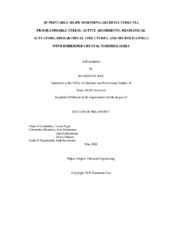| dc.description.abstract | 3D printing can manufacture polymer components with customized shapes and intricate structures easily without pre-made molds. When fabricated with responsive materials, smart 3D printed components experience shape morphing over time and display functionalities in response to external stimuli. However, due to an unfavorable combination of inaccessible printing systems and specially composited material mixtures employed in current studies, these smart components have yet to create sizable impact outside academic laboratories. This need was addressed by producing smart components using a commercially available fused deposition modeling printer and a single material, poly (lactic acid) (PLA), a biodegradable polyester with inherent shape memory properties, promising programmable and repeatable shape change in response to elevated temperatures. Combining the capillary force imposed by the microscale porous structures and the oleophilic surface properties of PLA produced rigid and reusable oil absorbents. Mathematical models were developed for the absorption behaviors as a guide to choose porous network architectures based on oil properties to maximize oil absorption efficiency. The commercialization potential of the absorbents was also explored.
Further examination of the 3D printed components revealed that thin samples warped when exposed to heat due to the release of printing generated-residual stresses. The correlation between warpage behaviors and printing parameters were assessed and implemented to develop a library of elements with programmable shape morphing features. By arranging these elements spatially, 2D structures capable of morphing into complex 3D topologies were produced. This was demonstrated by printing a sheet that morphed into a bio-inspired blooming lily displaying hierarchical structures.
3D printing facilitates the ease of producing customized parts, as demonstrated by development of a novel toolbox to manufacture microchannel devices in a lithography-free manner. In addition to enlisting 3D printing to produce customized assembly-ready channel covers, the advantage of enzymatic etching, thermal annealing, tape masking, and vacuum-aided bonding were also explored. The final product was a completely biodegradable assembled microchannel device with potential to perform bioanalysis. Furthermore, these research topics were utilized as a vehicle to engage undergraduate students in research activities and inspired a laboratory course providing hands-on experience for a conventional theory-only fluid mechanics course. | en |


